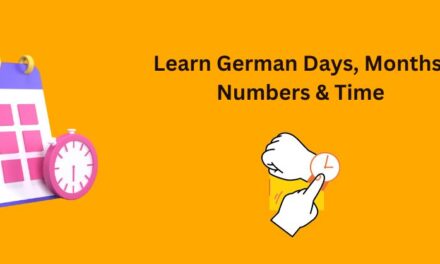The Easiest Way to Learn German Days, Months, Numbers & Time

Learning the German words for days, months, and numbers is an essential part of mastering the German language.
While the number system follows a similar logic to English, the days of the week and months of the year have their own unique German names that are important to memorize.
In this comprehensive guide, we will cover:
- The German days of the week
- The German months of the year
- Cardinal and ordinal numbers
- Telling time in German
- German date format
- Videos to learn the pronunciation
The Days of the Week in German
The German days of the week look quite different from their English counterparts. Here are the German days of the week with their English translations:
- Montag – Monday
- Dienstag – Tuesday
- Mittwoch – Wednesday
- Donnerstag – Thursday
- Freitag – Friday
- Samstag – Saturday
- Sonntag – Sunday
Watch the video to learn the correct pronunciation of Days and Months in German:
Der, Die or Das? A Beginner’s Guide to Mastering German Articles
Some things to note about the German days of the week:
- The first letter is always capitalized
- There are two days that contain the letter “g” – Dienstag and Donnerstag
- Wednesday directly translates to “mid week” (Mitte = middle)
- Saturday translates to “Sabbath day” based on its Hebrew origin
- Sunday is “Sun day” just like in English
Here are some examples of the days of the week used in sentences:
- Montag ist der erste Tag der Woche. – Monday is the first day of the week.
- Mittwoch haben wir Deutschunterricht. – On Wednesday we have German class.
- Ich liebe das Wochenende, besonders Samstag und Sonntag. – I love the weekend, especially Saturday and Sunday.
The Months of the Year in German
Like the days of the week, the German months also have their own unique names:
- Januar – January
- Februar – February
- März – March
- April – April
- Mai – May
- Juni – June
- Juli – July
- August – August
- September – September
- Oktober – October
- November – November
- Dezember – December
Some things to note about the German months:
- The first letter is always capitalized
- September to December are very similar to English
- Mai, Juni, and Juli end with an “i”
- März and April have umlauts (the two dots over a vowel)
Here are some examples of months used in sentences:
- Mein Geburtstag ist im Mai. – My birthday is in May.
- Dezember ist ein Wintermonat mit Schnee. – December is a winter month with snow.
- Wir gehen im August normalerweise in Urlaub. – We usually go on vacation in August.
An easy way to remember the months is by learning a common German rhyme:
Januar, Februar, März und April. Mai, Juni, Juli und August. September, November, Oktober Dezember.
Cardinal Numbers in German
The cardinal numbers in German from 0 to 10:
- Null – Zero
- Eins – One
- Zwei – Two
- Drei – Three
- Vier – Four
- Fünf – Five
- Sechs – Six
- Sieben – Seven
- Acht – Eight
- Neun – Nine
- Zehn – Ten
Some patterns to notice:
- The numbers eins to neun end with the same sound, similar to English
- Null has no English equivalent and means “zero”
- Zehn is “ten”
Here are the cardinal numbers 11 to 20:
- Elf – Eleven
- Zwölf – Twelve
- Dreizehn – Thirteen
- Vierzehn – Fourteen
- Fünfzehn – Fifteen
- Sechzehn – Sixteen
- Siebzehn – Seventeen
- Achtzehn – Eighteen
- Neunzehn – Nineteen
- Zwanzig – Twenty
The pattern continues where numbers 11-19 combine the unit with “zehn” (ten). Zwanzig is the exception for 20.
Guide to Mastering German Pronunciation
For tens, hundreds, thousands, millions, the German combines the root number word with the suffix -zig, -hundert, -tausend, -million:
- Zwanzig – Twenty
- Dreißig – Thirty
- Vierzig – Forty
- Fünfzig – Fifty
- Sechzig – Sixty
- Siebzig – Seventy
- Achtzig – Eighty
- Neunzig – Ninety
- Hundert – Hundred
- Tausend – Thousand
- Million – Million
Some examples:
- 68 – achtundsechzig (eight and sixty)
- 99 – neunundneunzig (nine and ninety)
- 578 – fünfhundertsiebenundsiebzig (five hundred seven and seventy)
- 1,342 – eintausenddreihundertzweiundvierzig (one thousand three hundred two and forty-two)
For larger numbers, German inserts “und” (and) between the hundreds and tens place:
- 2,500 – zweitausendfünfhundert
- 1,000,000 – eine Million
- 5,432,012 – fünf Millionen vierhundertzweiunddreißigtausendzwölf
Ordinal Numbers in German
Ordinal numbers indicate the order of things in a sequence (first, second, third, etc.). German ordinal numbers end in -te:
- Erste – First
- Zweite – Second
- Dritte – Third
- Vierte – Fourth
- Fünfte – Fifth
- Sechste – Sixth
- Siebte – Seventh
- Achte – Eighth
- Neunte – Ninth
- Zehnte – Tenth
For numbers above ten, replace the last digit with -ste:
- Elfte – Eleventh
- Zwölfte – Twelfth
- Zwanzigste – Twentieth
- Einundzwanzigste – Twenty-first
- Hundertste – Hundredth
- Tausendste – Thousandth
Watch the video to learn the pronunciation and exceptions of ordinal numbers in German:
More Numbers
- zehntausend – ten thousand
- hunderttausend – one hundred thousand
- eine Million – one million
- zehn Millionen – ten million
- hundert Millionen – one hundred million
- eine Milliarde – one billion
- eine Billion – one trillion
Telling Time in German
Telling time in German uses a 24-hour clock, so it’s important to know how to say hours 13-24:
- 13 – dreizehn
- 14 – vierzehn
- 15 – fünfzehn
- 16 – sechzehn
- 17 – siebzehn
- 18 – achtzehn
- 19 – neunzehn
- 20 – zwanzig
- 21 – einundzwanzig
- 22 – zweiundzwanzig
- 23 – dreiundzwanzig
- 24 – vierundzwanzig
To tell time, state the hour followed by the minutes. The word Uhr means “o’clock”:
- 8 Uhr – 8 o’clock
- 14 Uhr 30 – 14 hours 30 (2:30 pm)
- 18 Uhr 15 – 18 hours 15 (6:15 pm)
- 20 Uhr 45 – 20 hours 45 (8:45 pm)
Use halb for half past the hour:
- Halb neun – Half past eight (8:30)
- Halb vier – Half past three (3:30)
Use viertel vor/nach for quarter before/after the hour:
- Viertel nach sieben – Quarter after seven (7:15)
- Viertel vor elf – Quarter before eleven (10:45)
Use the contraction vor for minutes before the hour:
- 10 vor 8 – 10 minutes before 8 (7:50)
- 5 vor 12 – 5 minutes before 12 (11:55)
German Date Format
Dates are written in the order day-month-year in German:
- Montag, 1. Mai 2023 – Monday, May 1, 2023
Use ordinal numbers for the day:
- Der erste Mai – The first of May
The months are not capitalized when used in dates:
- Freitag, 15. juni 2018 – Friday, June 15, 2018
Some examples:
- Mein Geburtstag ist am siebten April. – My birthday is on April seventh.
- Silvester ist am einunddreißigsten Dezember. – New Year’s Eve is on December thirty-first.
- Wir gehen am Samstag, dem zwölften Mai ins Kino. – We are going to the movies on Saturday, May twelfth.
Conclusion
Learning the unique German names for days, months, and numbers takes some memorization, but will allow you to discuss dates and tell time like a native speaker.
Start by mastering the days of the week, months of the year, cardinal and ordinal numbers up to 100, and how to tell time. With practice, you’ll be able to understand schedules, make plans, read dates, and more in German.











